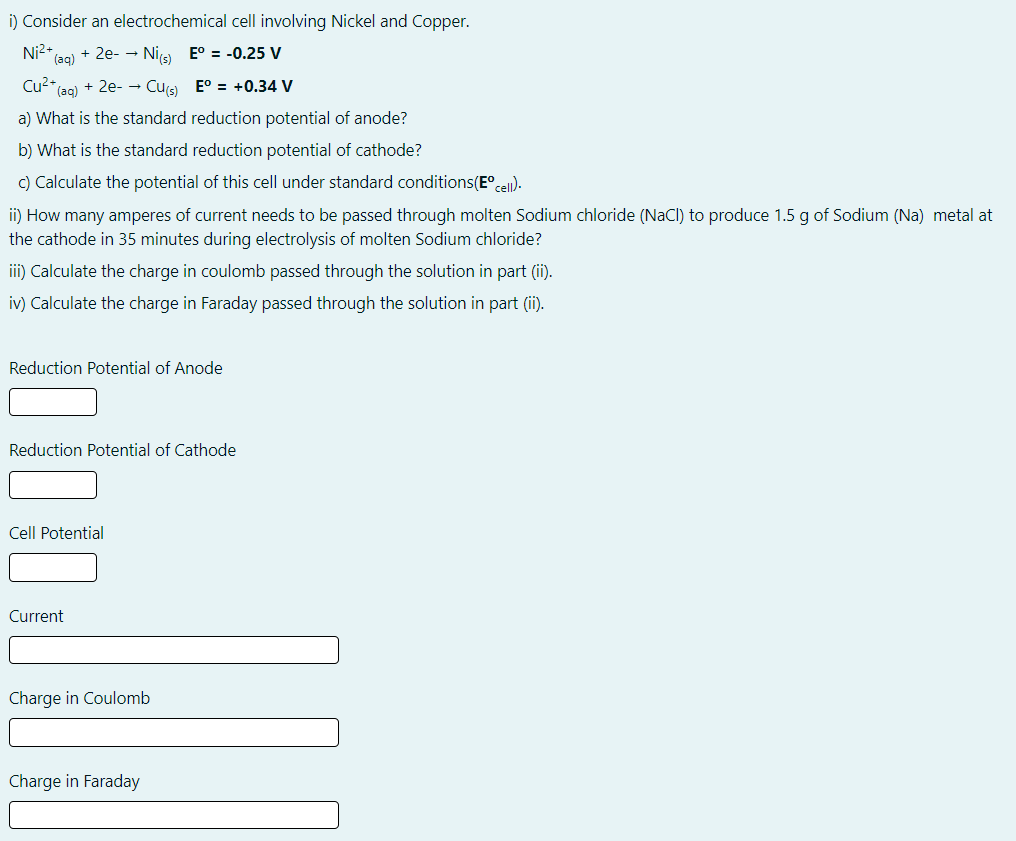i) Consider an electrochemical cell involving Nickel and Copper. Ni2- (aq) + 2e- - Nia E° = -0.25 V Cu2- (aq) + 2e- - Cu(s) E° = +0.34 V a) What is the standard reduction potential of anode? b) What is the standard reduction potential of cathode? c) Calculate the potential of this cell under standard conditions(E°cell). ii) How many amperes of current needs to be passed through molten Sodium chloride (NaCl) to produce 1.5 g of Sodium (Na) metal at the cathode in 35 minutes during electrolysis of molten Sodium chloride? ii) Calculate the charge in coulomb passed through the solution in part (ii). iv) Calculate the charge in Faraday passed through the solution in part (ii). Reduction Potential of Anode Reduction Potential of Cathode Cell Potential Current Charge in Coulomb Charge in Faraday
i) Consider an electrochemical cell involving Nickel and Copper. Ni2- (aq) + 2e- - Nia E° = -0.25 V Cu2- (aq) + 2e- - Cu(s) E° = +0.34 V a) What is the standard reduction potential of anode? b) What is the standard reduction potential of cathode? c) Calculate the potential of this cell under standard conditions(E°cell). ii) How many amperes of current needs to be passed through molten Sodium chloride (NaCl) to produce 1.5 g of Sodium (Na) metal at the cathode in 35 minutes during electrolysis of molten Sodium chloride? ii) Calculate the charge in coulomb passed through the solution in part (ii). iv) Calculate the charge in Faraday passed through the solution in part (ii). Reduction Potential of Anode Reduction Potential of Cathode Cell Potential Current Charge in Coulomb Charge in Faraday
Chemistry: An Atoms First Approach
2nd Edition
ISBN:9781305079243
Author:Steven S. Zumdahl, Susan A. Zumdahl
Publisher:Steven S. Zumdahl, Susan A. Zumdahl
Chapter17: Electrochemistry
Section: Chapter Questions
Problem 135CWP: Consider a galvanic cell based on the following half-reactions: a. What is the expected cell...
Related questions
Question

Transcribed Image Text:i) Consider an electrochemical cell involving Nickel and Copper.
Ni2-
(aq)
+ 2e- - Nia E° = -0.25 V
Cu2-
(aq) + 2e- - Cu(s) E° = +0.34 V
a) What is the standard reduction potential of anode?
b) What is the standard reduction potential of cathode?
c) Calculate the potential of this cell under standard conditions(E°cell).
ii) How many amperes of current needs to be passed through molten Sodium chloride (NaCl) to produce 1.5 g of Sodium (Na) metal at
the cathode in 35 minutes during electrolysis of molten Sodium chloride?
ii) Calculate the charge in coulomb passed through the solution in part (ii).
iv) Calculate the charge in Faraday passed through the solution in part (ii).
Reduction Potential of Anode
Reduction Potential of Cathode
Cell Potential
Current
Charge in Coulomb
Charge in Faraday
Expert Solution
This question has been solved!
Explore an expertly crafted, step-by-step solution for a thorough understanding of key concepts.
This is a popular solution!
Trending now
This is a popular solution!
Step by step
Solved in 3 steps

Knowledge Booster
Learn more about
Need a deep-dive on the concept behind this application? Look no further. Learn more about this topic, chemistry and related others by exploring similar questions and additional content below.Recommended textbooks for you

Chemistry: An Atoms First Approach
Chemistry
ISBN:
9781305079243
Author:
Steven S. Zumdahl, Susan A. Zumdahl
Publisher:
Cengage Learning

Chemistry
Chemistry
ISBN:
9781305957404
Author:
Steven S. Zumdahl, Susan A. Zumdahl, Donald J. DeCoste
Publisher:
Cengage Learning


Chemistry: An Atoms First Approach
Chemistry
ISBN:
9781305079243
Author:
Steven S. Zumdahl, Susan A. Zumdahl
Publisher:
Cengage Learning

Chemistry
Chemistry
ISBN:
9781305957404
Author:
Steven S. Zumdahl, Susan A. Zumdahl, Donald J. DeCoste
Publisher:
Cengage Learning


Chemistry: Principles and Reactions
Chemistry
ISBN:
9781305079373
Author:
William L. Masterton, Cecile N. Hurley
Publisher:
Cengage Learning

Chemistry & Chemical Reactivity
Chemistry
ISBN:
9781133949640
Author:
John C. Kotz, Paul M. Treichel, John Townsend, David Treichel
Publisher:
Cengage Learning

Chemistry & Chemical Reactivity
Chemistry
ISBN:
9781337399074
Author:
John C. Kotz, Paul M. Treichel, John Townsend, David Treichel
Publisher:
Cengage Learning